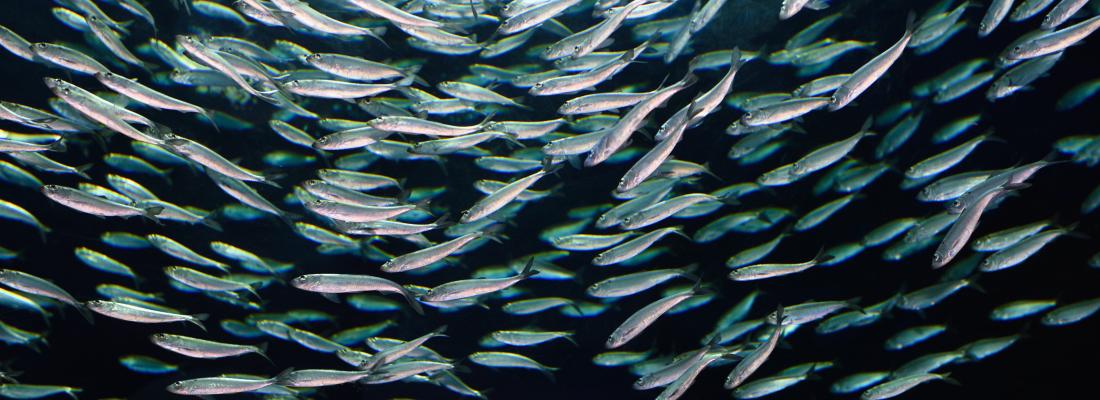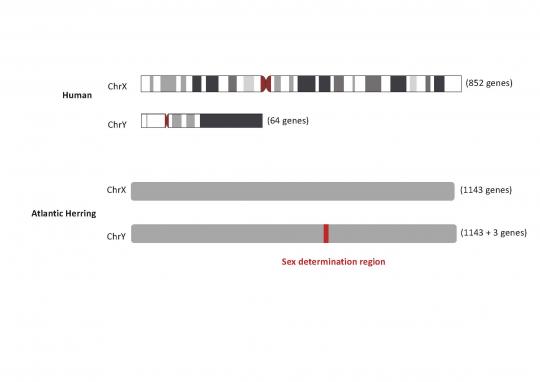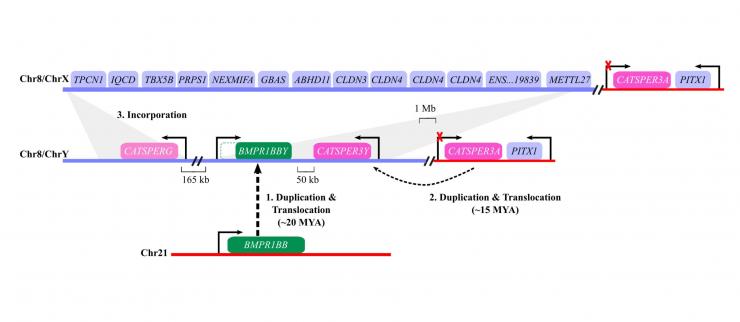Biodiversity Reading time 3 min
The birth of a male sex chromosome in Atlantic herring
Published on 07 September 2020

It is hard to study the early evolution of sex chromosomes because it usually happened a long time ago and the sex determining chromosome usually rapidly degenerates and accumulates repetitive sequences. For instance, humans have an X/Y system of sex determination and presence of Y determines male sex. Human chromosome Y was established more than 100 million years ago and evolved from a chromosome identical to the X chromosome but has since then lost most of the genes present on X and its size is only about 1/3 the size of chromosome X. The Atlantic herring has also an X/Y system but it is young and evolved much more recently. In the herring X and Y are almost identical in gene content, the only difference is that the Y has three additional genes, a sex-determining factor (BMPR1BBY) and two sperm protein genes predicted to be essential for male fertility (Image 1).

“The unique feature of this study is that we have been able to reconstruct the birth of a sex chromosome”, explains Nima Rafati, scientist at Uppsala University and first author on the paper. “The evolution of the herring Y chromosome in fact resembles the process when my son makes a construction with pieces of Lego”, continues Nima Rafati (Image 2). Two of the building blocks were formed when extra copies of two different genes emerged and were translocated to what became a male-specific region that cannot exchange genetic material with the X chromosome. It was followed by the incorporation of a third gene to the male-specific region and its loss from the X chromosome.

“The Y-specific gene BMPR1BBY is most certainly the sex determining factor in Atlantic herring since it belongs to a family of proteins with a critical role in inducing the development of testis”, explains Amaury Herpin scientist at INRAE (France) and one of the shared first authors. The evolution of BMPR1BBY is a wonderful example of molecular evolution in action. It shows how random mutations and natural selection can “create” a new gene, continues Amaury Herpin. BMPR1BBY contains about 50 mutations compared with the autosomal copy but it maintains its ability to promote testis development and it evolved an ability to act independently of some of the cofactor the autosomal copy requires and therefore provides a shortcut to the induction of testis development.
It has previously been proposed that the presence of a sex-determining factor is not sufficient for the evolution of a sex chromosome, it requires the close association between a sex-determining factor and one or more genes beneficial for that sex, explains Manfred Schartl professor at Würzburg University and one of the co-authors of the study. “This is exactly what the herring Y chromosome provides, a male determining factor (BMPR1BBY) and two genes for sperm proteins predicted to be essential for male fertility”.
“We are now working on a follow up study by making an assembly of the sprat genome”, states Leif Andersson professor at Uppsala University who led the study. “Sprat is a close relative to the herring and this analysis will allow us to make a more precise estimate when this Y chromosome evolved, how stable it is and how rapidly it evolves”, ends Leif Andersson.
|
Reference Nima Rafati, Junfeng Chen, Amaury Herpin, Mats Pettersson, Fan Han, Chungang Feng, Ola Wallerman, Carl-Johan Rubin, Sandrine Péron, Arianna Cocco, Mårten Larsson, Christian Trötschel, Ansgar Poetsch, Kai Korsching, Wolfgang Bönigk, Heinz G. Körschen, Florian Berg, Arild Folkvord, U. Benjamin Kaupp, Manfred Schartl, Leif Andersson PNAS http://dx.doi.org/10.1073/pnas.2009925117 |
